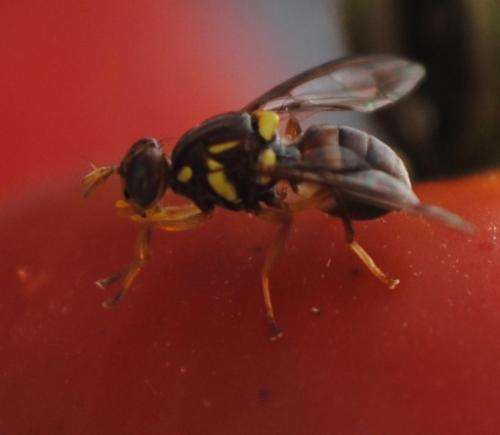New research reveals clock ticking for fruit flies

The army of pesky Queensland fruit flies that annually inflict many millions of dollars-worth of damage on the nation's horticultural industry may be about to see their numbers take a significant dive thanks to research by scientists from the University of Western Sydney and the University of New South Wales.
The research breakthrough, published in the internationally leading journal Insect Molecular Biology, identifies the exact point in time when developing fruit fly pests become either male or female. Armed with this critical information, scientists plan to breed single-sex sterile male fruit flies that can be released in large numbers thereby suppressing pest populations in the field without any environmental impacts.
The breakthrough will be welcome news for farmers in Australia's multi-billion dollar fruit growing industry who have seen their pest control options gradually diminish. For many years the control relied on the use of organophosphate insecticides such as dimethoate and fenthion that have become severely restricted in use due to their potential risk to human health and the environment.
Understanding the mechanisms and timing of how insects become either male or female is critical for the development of new bacterial or genetic approaches to pest control, says lead author of the study, Dr Jennifer Morrow from the UWS Hawkesbury Institute for the Environment.
The challenge now will be producing sufficient quantities of sterilised fruit flies for release.
The research reveals when specific genes are expressed to form proteins that then influence sex determination in the early hours of embryonic development of the Queensland fruit fly and a related species, soon after eggs are laid into fruit. This means there is now a better understanding of how and when common species of pest fruit flies turn on or off production of proteins that make flies into females.
Our research significantly adds to understanding the key process of sex determination in this destructive crop pest. This knowledge could enable the industry to develop fruit fly lines that can be used to produce male-only broods in huge quantities. They may be intrinsically sterile or may be sterilised before release, for example by gamma irradiation, Dr Morrow says.
The combination of new male-only lines, plus the use of inherited bacteria such as Wolbachia that cause crossing incompatibilities in insects will provide new avenues to control fruit fly in an environmentally friendly way, says Dr Markus Riegler, team leader of the fruit fly research at the UWS Hawkesbury Institute of the Environment.
We've made a good advance, say Dr Marianne Frommer and Dr Deborah Shearman from the fruit fly research team at the University of New South Wales.
Whatever mechanism for developing a sterile male-only line, knowing the timing of sex determination in Australian pest fruit flies will be critical, they say.
More information: Morrow JL, Riegler M, Frommer M and Shearman DCA, (2014) Expression patterns of sex determination genes in single male and female embryos of two Bactrocera fruit fly species during early development , Insect Molecular Biology, DOI: 10.1111/imb.12123
Morrow JL, Frommer M, Shearman DCA, Riegler M (2014) Tropical tephritid fruit fly community with high incidence of shared Wolbachia strains as platform for horizontal transmission of endosymbionts(opens in new window), Environmental Microbiology, DOI: 10.1111/1462-2920.12382
Journal information: Environmental Microbiology



















